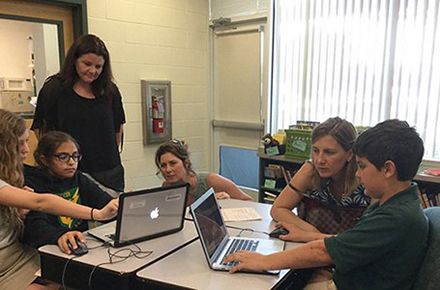

Fifth Graders Colonize Mars through Minecraft
Source/Author: Raffi Darrow, Ebytes Editor
May 18, 2018
For the third year, fifth graders have used MinecraftEdu to present a cross-curricular, capstone project to parents and peers about colonizing Mars.
While brainstorming projects to engage her fifth grade math class, Mandy Howell discovered that other teachers were using Minecraft as a learning tool. “In fifth grade math, the main geometry objective is calculating volume of regular and composite figures based on blocks, as well as reviewing calculating area and perimeter, and Minecraft is based on blocks. I knew our kids were really engaged in Minecraft, and making calculations about figures built in Minecraft would get them excited about the learning,” Mrs. Howell recalls.
While brainstorming projects to engage her fifth grade math class, Mandy Howell discovered that other teachers were using Minecraft as a learning tool. “In fifth grade math, the main geometry objective is calculating volume of regular and composite figures based on blocks, as well as reviewing calculating area and perimeter, and Minecraft is based on blocks. I knew our kids were really engaged in Minecraft, and making calculations about figures built in Minecraft would get them excited about the learning,” Mrs. Howell recalls.
Mrs. Howell also knew her students were studying Mars in science class. She approached fifth grade science teacher Selene Willis. The two teachers decided to collaborate on a project using MinecraftEdu software in which their students would create a 3D model of a Mars colony.
Before presenting the project to the students, the science curriculum frontloaded them with information. First, they learned the basics of astronomy and studied similarities and differences between Earth and Mars. A whiteboard was set up in fifth grade with the question: Should humans travel to Mars? Students had a sticky note with their name on the board, and as they learned new information they could move their name between the Yes column and No column to represent their current stance on the topic.
“We learned a lot of the science before [...] so students could answer questions like: What is Mars like? What are the constraints that we need to worry about if we actually go to Mars? Once they learned about the project, they were able to then transfer that knowledge,” Ms. Willis reported.
For the next part of the project, the grade researched what a colony might need to survive on Mars. Students were broken into small groups to represent scientists in charge of air quality, water, food production, transportation, communication, energy resources, housing, sacred spaces and a medical team. Each group was tasked with designing a pod for their sector that could withstand Mars’ environment.
Mrs. Annie Meier, a chemical engineer at NASA’s Kennedy Space Center, Skyped with the grade and told them about her experience as part of the 120-day HI-SEAS (Hawai'i Space Exploration Analog and Simulation) program. HI-SEAS is a habitat on an isolated Mars-like site on the Mauna Loa volcano on Hawaii's Big island. The location offers not only physical isolation, such that astronauts experience, but also geological similarity to the surface of Mars. She shared many photographs of the simulated spacewalks and highlighted her study on NASA’s possible plans to turn trash and waste into fuel, water and breathable oxygen during deep space travel. Additionally, she highlighted the design of the habitat and shared the psychological factors and effects of being isolated from the world for an extended period of time. Finally, Mrs. Meier highlighted many more challenges that astronauts will have to understand and solve as NASA plans to explore the red planet in the future.
Armed with this new information, teams planned their pods in 2D on graph paper, and then the grade gathered around a rug-sized grid sheet to plan which pod would go where. They discussed proximity of pods that needed to use each other’s resources, like putting water near food production to help plants grow, and also putting more frequently used pods in the center of the layout so they were easy for everyone to get to. Train tracks outlined the pods.
Ms. Willis was excited about the unexpected learning that came from everyone thinking of the common good to determine the layout of the colony. “They got to actually learn how to negotiate and talk about what’s more important than something else, and learn how to let go of what they wanted and think about what would be best for the Mars colony. That was a huge experience for them.” These types of collaborative skills prepare students for real-life team efforts in the future.
Once the colony’s map was finalized, students finally built 3D models in Minecraft. They were given latitude and longitude coordinates of where the cornerstone of their building belonged and which directions to build, adding skills learned in geography to the project, and ensuring that the 2D layout was replicated correctly.
The final phase of the process for most project-based learning is reflection. In written reflections, students explained what materials they used for their building and why. They downloaded images of interior and exterior views of their pods to their iPads and added their mathematical calculations.
In the end, Mrs. Howell said students were “eager to work on it the whole time and to see the math through. Technology is always super engaging for the kids.”
The final Mars colony was shared with peers and parents. Deep and active learning applied in the project empowered students to establish themselves as expert Mars colony tour guides.
View more photos from their project showcase here:
The final Mars colony was shared with peers and parents. Deep and active learning applied in the project empowered students to establish themselves as expert Mars colony tour guides.
View more photos from their project showcase here:

















![MS Awards Assembly [Photos, Video] MS Awards Assembly [Photos, Video]](/Images/1px.png?command_1=url&url_1=https%3A%2F%2Fwww.shorecrest.org/userfiles/shpsv2mvc/images/news-images/2025/msawards.JPG&command_2=resize&height_2=85)






